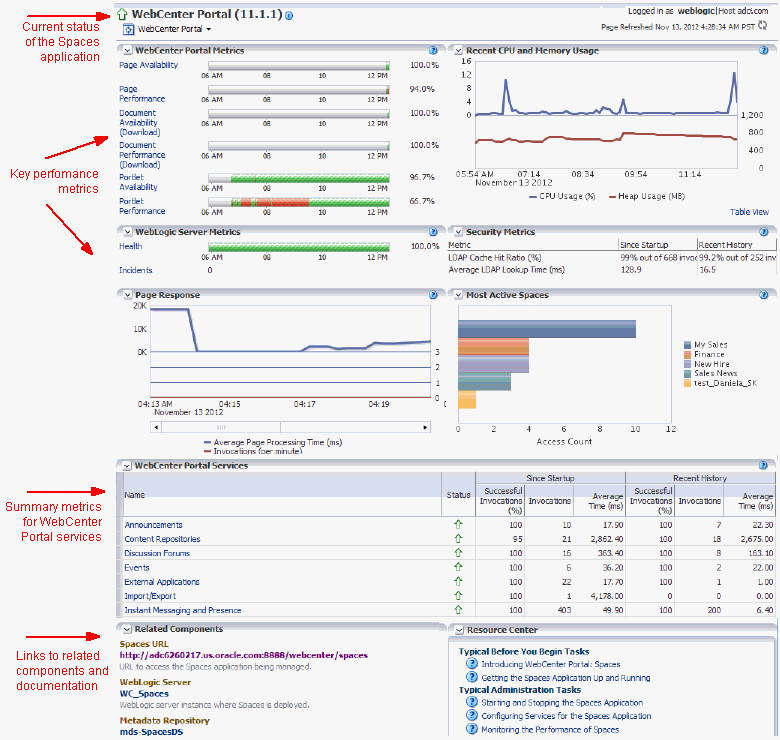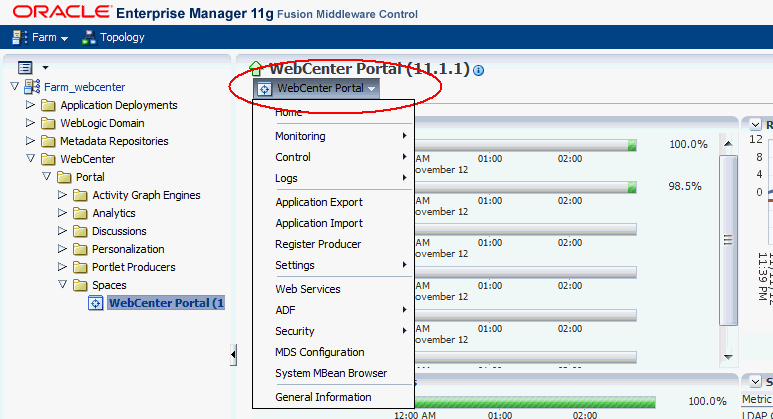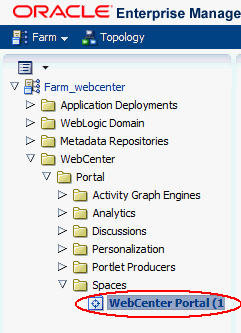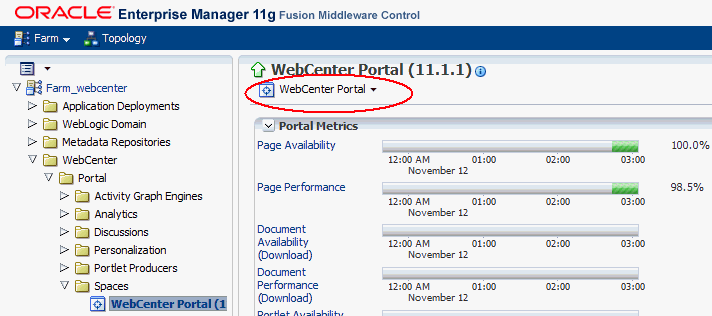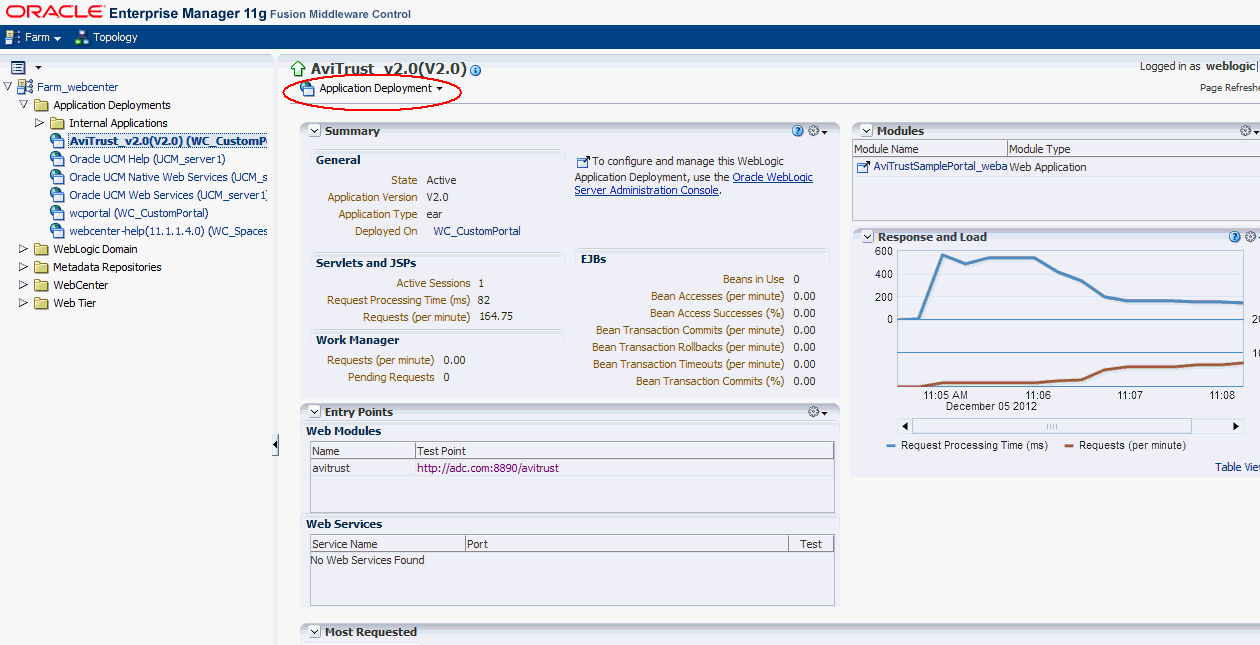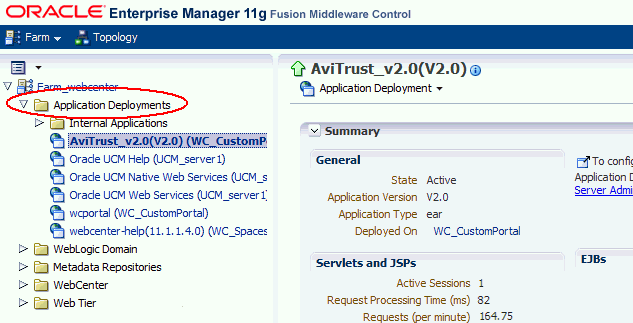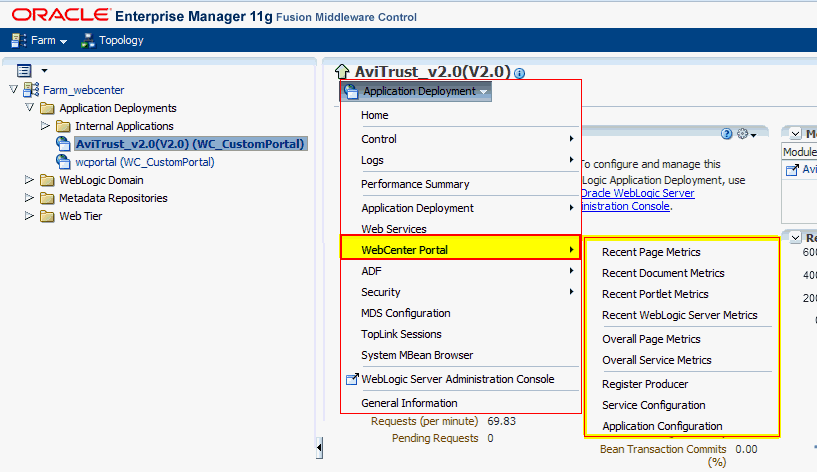6 Starting Enterprise Manager Fusion Middleware Control
This chapter describes how to access Oracle Enterprise Manager Fusion Middleware Control Console, and display WebCenter Portal-related pages from where you can perform all necessary configuration, monitoring, and management tasks.
This chapter includes the following sections:
-
Section 6.2, "Navigating to the Home Page for the Spaces Application"
-
Section 6.3, "Navigating to the Home Page for Framework Applications"
The content of this chapter is intended for Fusion Middleware administrators (users granted the Admin, Operator, or Monitor role through the Oracle WebLogic Server Administration Console). See also, Section 1.8, "Understanding Administrative Operations, Roles, and Tools".
6.1 Displaying Fusion Middleware Control Console
Fusion Middleware administrators can login to Fusion Middleware Control Console and access pages for managing WebCenter Portal. Your role determines what you can see and do after logging in. To find out more, see Table 1-7, "WebCenter Portal Operations and Oracle WebLogic Server Roles".
To access the Fusion Middleware Control Console:
-
Start Fusion Middleware Control.
Fusion Middleware Control is configured for a domain, and it is automatically started when you start the Oracle WebLogic Server Administration Server. See "Starting and Stopping Fusion Middleware Control" in Oracle Fusion Middleware Administrator's Guide.
-
Enter the following URL in y our browser:
http://hostname.domain:port/emFor example:
http://myhost.mycompany.com:7001/emThe port number is the port number of the Administration Server. By default, the port number is 7001. The port number is listed in
config.xml:-
On Windows:
DOMAIN_HOME\config\config.xml -
On UNIX:
DOMAIN_HOME/config/config.xml
See also, "Managing Ports" in Oracle Fusion Middleware Administrator's Guide.
-
-
Enter a valid administrator User Name and Password details for the farm.
The default user name for the administrator user is
weblogic. This is the account you can use to log in to Fusion Middleware Control for the first time. -
Click Login.
The first page you see is the Farm home page. You can view this page at any time by selecting the name of the farm in the navigation pane (Figure 6-1).
Tip:
If you are unable to log in, try logging in to the WebLogic Administration Console to confirm your host/port/credentials. The Weblogic Admin Console is accessible at the same host/port as Fusion Middleware Control:
http://host.domain:port/console
From the navigation pane, you can drill down to view and manage all components in your farm, including the Spaces application and any Framework application that you may have deployed. For detailed instructions, see:
6.2 Navigating to the Home Page for the Spaces Application
The Spaces home page (Figure 6-2) is your starting place for managing the Spaces application. The page displays status, performance and availability of all the components and services that make up the Spaces application.
Note:
Versions that display alongside WebCenter Portal product and component names in Fusion Middleware Control do not reflect the true version number of installed products. To verify which WebCenter Portal product version you have installed, refer to Appendix D, "How Do I Find Out Which WebCenter Portal Version Is Installed?".
The metrics displayed on the Spaces home page enable you to:
-
Check the status of the Spaces application and view key performance data.
-
Quickly see whether the application is performing as expected through charts that immediately report:
-
availability and performance issues with pages, documents, and portlets
-
general health of the WebLogic Server and the back-end LDAP server
Hover over the links in the WebCenter Portal Metrics and WebLogic Server Metrics sections for a brief description about the information displayed and click the links to drill down to more detail.
-
-
Monitor CPU and heap memory usage charts to detect whether system resources are running low.
-
Track overall response time compared with the user access rate to see how the application preforms under different loads and to diagnose system resource issues.
-
Quickly see which spaces are used the most, and then drill down to see the slowest performers, and determine which spaces are recording the most errors.
-
View status and key performance metrics for WebCenter Portal services used in the application.
-
Drill down to detailed performance information for individual spaces, services, external applications, portlets, and producers.
-
Navigate to other key components, including the WebLogic Server managed server on which the Spaces application is running, and the MDS repository.
Note:
To find out more about the performance metrics displayed on the home page, what to look out for, and how to diagnose issues with your installation, see Section 39.1.3, "Using Key Performance Metric Data to Analyze and Diagnose System Health".
The Spaces home page also displays a WebCenter Portal menu (Figure 6-3).
To navigate to the main home page for Spaces:
-
Login to Fusion Middleware Control.
See Section 6.1, "Displaying Fusion Middleware Control Console".
-
In the Navigator (Figure 6-4), expand WebCenter > Portal > Spaces.
-
Select WebCenter Portal to navigate to the home page for your Spaces installation (Figure 6-4).
Notice how the Navigator menu changes to WebCenter Portal (Figure 6-5).
Another way to access the context menu for a particular component is to right-click the node in the navigation tree. For example, if you right-click the WebCenter Portal (11.1.1) node (under the Spaces node on the left in Figure 6-5), the same WebCenter Portal menu displays.
From the WebCenter Portal menu, you can:
-
Drill down to detailed performance metrics for all components
-
Configure security policies and roles
-
Configure ADF and MDS options
-
View Web Services-related information
-
Most tasks that you perform from the WebCenter Portal home page are described in this Guide. To help guide you to the appropriate chapter or section, refer to Chapter 2, "Getting the Spaces Application Up and Running".
6.3 Navigating to the Home Page for Framework Applications
The J2EE Application Deployment home page (Figure 6-6) is your starting place for managing portal application deployments developed with WebCenter Portal: Framework. The page displays status, performance and availability of all the components and services that make up the Framework application.
Note:
Versions that display alongside WebCenter Portal product and component names in Fusion Middleware Control do not always reflect the true version number of installed products. To verify which WebCenter Portal product version you have installed, refer to Appendix D, "How Do I Find Out Which WebCenter Portal Version Is Installed?".
Note:
The Spaces application has a different home page, see Navigating to the Home Page for the Spaces Application.
From here you can:
-
Check Framework application status.
-
Navigate to the Oracle WebLogic Server Administration Console.
-
Access various standard Application Deployment menu options:
-
Start, restart, and shutdown the application
-
View and configure log files
-
Undeploy and redeploy the application
-
Configure security policies and roles
-
Configure ADF and MDS options
-
-
View a performance summary, entry points to the application, Web Services and modules associated with the application, and the response and load data which shows the requests per second and the request processing time.
-
Navigate to key components of the Framework application.
-
Drill down to detailed performance information for individual modules and services.
Note:
To find out more about the performance metrics displayed on the home page, what to look out for, and how to diagnose issues with your installation, see Section 39.1.3, "Using Key Performance Metric Data to Analyze and Diagnose System Health".
To navigate to the main home page for your Framework application:
-
Login to Fusion Middleware Control.
See Section 6.1, "Displaying Fusion Middleware Control Console".
-
In the Navigator (Figure 6-7), expand Application Deployments.
-
Select the name of your Framework application to display the application's home page.
Notice that the Application Deployment menu displays an additional menu option—WebCenter Portal.Figure 6-8).
From the WebCenter Portal menu, you can perform WebCenter Portal-specific tasks such as:
-
Monitor detailed WebCenter Portal performance metrics:
-
Recent page, document, portlet producer, and WebLogic Server metrics.
-
Overall page and service metrics.
See also Chapter 39, "Monitoring Oracle WebCenter Portal Performance").
-
-
Register and manage portlet producers (see Chapter 24, "Managing Portlet Producers").
-
Configure application settings (see Section 9.2, "Setting Application Properties for Framework Applications").
-
Manage connections to back-end services (see Chapter 10, "Managing Oracle WebCenter Portal Services").
-
Manage external applications (see Chapter 26, "Managing External Applications").
-
6.4 Navigating to Dependent Components
From WebCenter Portal pages it is easy to navigate to pages belonging to related components, such as, WebLogic Server domains, servers, Java components, MDS repository, and so on.
-
Spaces application - From the home page, click links in "Related Components" to navigate to Spaces application itself, WebLogic Server installation pages, and MDS repository pages in Fusion Middleware Control. See also, Section 6.2, "Navigating to the Home Page for the Spaces Application".
-
Framework applications - The Application Deployment menu on the J2EE application home page offers direct navigation to the Oracle WebLogic Server Administration Console, and pages relating to WebCenter Portal, ADF, MDS repository, and security configuration and administration. See also, Section 6.3, "Navigating to the Home Page for Framework Applications".

